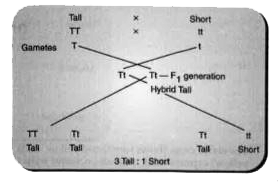With the help of a cross done with garden pea plants, trace the work done by Mendel with a tall and a short plant to arrive at a 3:1 ratio in the F2 generation.Solution in Kannada
cross

Topper's Solved these Questions
- BOOK - OSWAAL PUBLICATIONCHAPTER - HEREDITY AND EVOLUTIONEXERCISE - TOPIC - 1 (HEREDITY AND MENDEL.S CONTRIBUTION)(LONG ANSWER TYPE QUESTIONS)6videos
HEREDITY AND EVOLUTION
- BOOK - OSWAAL PUBLICATIONCHAPTER - HEREDITY AND EVOLUTIONEXERCISE - TOPIC - 2 (ORIGIN OF LIFE AND EVOLUTION)(MULTIPLE CHOICE QUESTION)1videos
HEREDITY AND EVOLUTION
- BOOK - OSWAAL PUBLICATIONCHAPTER - HEREDITY AND EVOLUTIONEXERCISE - TOPIC - 1 (HEREDITY AND MENDEL.S CONTRIBUTION)(SHORT ANSWER TYPE QUESTIONS - I)10videos
HEREDITY AND EVOLUTION
- BOOK - OSWAAL PUBLICATIONCHAPTER - CONTROL AND CO-ORDINATIONEXERCISE - NCERT CORNER (Textbook Exercises)12videos
CONTROL AND CO-ORDINATION
- BOOK - OSWAAL PUBLICATIONCHAPTER - HOW DO ORGANISMS REPRODUCE?EXERCISE - NCERT CORNER (TEXTBOOK EXERCISES)11videos
HOW DO ORGANISMS REPRODUCE?
Similar Questions
(a) Why did Mendel choose garden pea for his experiments? Write two reasons.
(b) List two contrasting visible characters of garden pea Mendel used for his experiment.
(c) Explain in brief how Mendel interpreted his results to show that the traits may be dominant or recessive.02:58View SolutionIdentify the correct pair of analogous organ from the following:
02:21View SolutionWhat are characteristics? Give an example.
03:34View SolutionWhich of the following is a plant hormone ?
02:40View SolutionAsexual reproduction takes place through budding in
04:31View SolutionTo determie the genotype of a tall plant of F2 generation, Mendel crossed this plant with a dwarf plant. This cross represents a
04:20View SolutionA tall true breeding garden pea plant is crossed with a dwarf true breeding garden pea plant. When the F1 plant were selfed the resulting genotypeswere in the ratio of
05:09View SolutionIn peas, a pure tall plant (TT) is corssed with a short plante(tt). The ratio of pure tall plants to short plants in F_(2) is
01:33View SolutionPure-bred tall pea plants are first crossed with pure-bred dwarf pea plants. The pea plants obtained in F_(1) generation are then cross-bred to produce F_(2) generation of pea plants. (i) What do the plants of F_(1) generation look like ? (b) What is the ratio of all plants to dwarf plants in F_(2) generation ? (c) Which type of plants were missing in F_(1) generation but reappeared in F_(2) generation ?
02:18View SolutionMendel took tall pea plants and short pea plants and produced F1 progeny through cross fertilisation. What did Mendel observe in the F1 progeny ?
02:42View SolutionA tall true breeding garden pea plant is crossed with a dwarf true breeding garden pea plant. Whan the F_(1) plants were selfed the resulting genotypes were in the ratio of :
04:44View SolutionPure-bred tall pea plants are first crossed with pure-bred dwarf pea plants. The pea plants obtained in F1 generation are then cross-bred to produce F2 generation of pea plants.
(a) What do the plants of F1 generation look like?
(b) What is the ratio of tall plants to dwarf plants in F2 generation?
(c ) Which type pf plants were missing in F1 generation but reappeared in F2 generation?02:03View SolutionIn a cross between a tall pea plant (TT) and a short pea plant (tt), what will be the characteristics shown by the F1 generation?
02:16View SolutionIn a monohybrid cross between tall pea plants (TT) and short pea plants (tt) a scientist obtained only tall pea plants (Tt) in the F1 generation. However, on selfing the F1 generation pea plants, he obtained both tall and short plants in F2 generation. On the basis of above observations with other angiosperms also, can the scientist arrive at a law? If yes, explain the law. If not, give justification for your answer.
04:40View SolutionIn Mendel's monohybrid cross between tall and short pea plants, all offsprings were tall. What does this tell us about the trait? What is the ratio of tall and short plants in the F2 generation?
02:48View Solution

